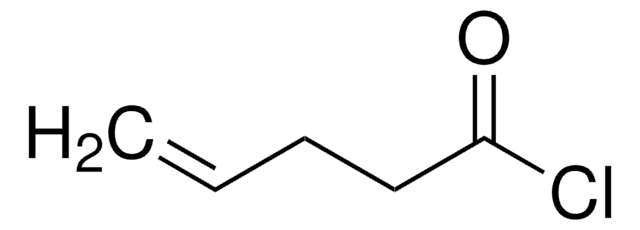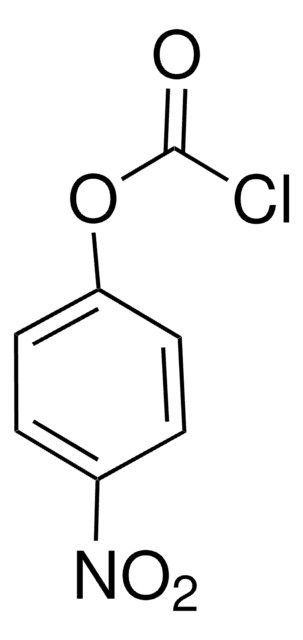추천 제품
vapor density
>1 (vs air)
Quality Level
vapor pressure
1.93 psi ( 20 °C)
분석
97.0%
포함
<210 ppm MEHQ as stabilizer
refractive index
n20/D 1.435 (lit.)
bp
72-76 °C (lit.)
density
1.114 g/mL at 25 °C (lit.)
저장 온도
2-8°C
SMILES string
ClC(=O)C=C
InChI
1S/C3H3ClO/c1-2-3(4)5/h2H,1H2
InChI key
HFBMWMNUJJDEQZ-UHFFFAOYSA-N
유사한 제품을 찾으십니까? 방문 제품 비교 안내
일반 설명
Acryloyl chloride is a derivative of acrylic acid and is widely used as a reactive monomer in the synthesis of various polymers with desired properties such as good transparency, flexibility, excellent mechanical and thermal properties, and resistance to moisture and chemicals. Acryloyl chloride contains both an acryloyl group (-CH2=CHC(O)Cl) and a chloride functional group (-Cl) in its structure. This combination of functional groups enables acryloyl chloride to undergo polymerization reactions and participate in copolymerization processes. In the field of polymers, acryloyl chloride is commonly used in the production of acrylic polymers, such as polyacrylates and polymethacrylates. These polymers have a wide range of applications, including coatings, adhesives, sealants, textiles, and biomedical materials.
애플리케이션
Acryloyl chloride can used as a monomer in the synthesis of:
- Acrylic polymers via radical polymerization or copolymerization. These acrylic polymers can be tailored to possess the desired properties for biomedical coatings, including biocompatibility, adhesion to the device surface, and durability.
- Poly(styrene-co-acryloyl chloride) copolymer by crosslinked networks with styrene. The resulting crosslinked polymer can then be functionalized or modified by various chemical reactions to introduce specific properties or functionalities desired for the application as a polymer support or an electrophilic scavenger resin.
- Acrylamide-modified chitosan.
- Ulvan acrylate macromer via esterification of hydroxyl groups of polysaccharides. This macromer can be used to prepare ulvan-based thermosensitive hydrogels.
- Degradable peptide cross-linker by the acrylation of the amine groups of lysine residues and glutamine within peptide sequences.
신호어
Danger
유해 및 위험 성명서
Hazard Classifications
Acute Tox. 1 Inhalation - Acute Tox. 4 Oral - Eye Dam. 1 - Flam. Liq. 2 - Met. Corr. 1 - Skin Corr. 1A
보충제 위험성
Storage Class Code
3 - Flammable liquids
WGK
WGK 3
Flash Point (°F)
30.2 °F
Flash Point (°C)
-1 °C
Soyeon Kim et al.
Biomacromolecules, 4(5), 1214-1223 (2003-09-10)
Hydrogels composed of N-isopropylacrylamide (NIPAAm) and acrylic acid (AAc) were prepared by redox polymerization with peptide cross-linkers to create an artificial extracellular matrix (ECM) amenable for testing hypotheses regarding cell proliferation and migration in three dimensions. Peptide degradable cross-linkers were
Andrea Morelli et al.
Carbohydrate polymers, 136, 1108-1117 (2015-11-18)
The present study is focused on the exploitation and conversion of sulphated polysaccharides obtained from waste algal biomass into high value added material for biomedical applications. ulvan, a sulphated polysaccharide extracted from green seaweeds belonging to Ulva sp. was selected
Iris Ben-David et al.
Applied radiation and isotopes : including data, instrumentation and methods for use in agriculture, industry and medicine, 58(2), 209-217 (2003-02-08)
An automated procedure for the radiosynthesis of the labeling synthon [11C]acryloyl chloride was developed and applied for labeling several N-acryl amides with carbon-11. [11C]-6-acrylamido-4-(3,4-dichloro-6-fluoroanilino)quinazoline (ML03), a novel PET biomarker targeting the epidermal growth factor receptor tyrosine kinase (EGFr-TK) in cancer
V Fulcrand et al.
International journal of peptide and protein research, 38(3), 273-277 (1991-09-01)
Copolymers of acrylated derivatives of alpha-chymotrypsin and polyethylene glycol (PEG) have been prepared and used as biocatalysts for the synthesis of model peptides in organic solvent containing a low quantity of water. Other peptide couplings have been tried to point
J C Tiller et al.
Proceedings of the National Academy of Sciences of the United States of America, 98(11), 5981-5985 (2001-05-17)
Poly(4-vinyl-N-alkylpyridinium bromide) was covalently attached to glass slides to create a surface that kills airborne bacteria on contact. The antibacterial properties were assessed by spraying aqueous suspensions of bacterial cells on the surface, followed by air drying and counting the
자사의 과학자팀은 생명 과학, 재료 과학, 화학 합성, 크로마토그래피, 분석 및 기타 많은 영역을 포함한 모든 과학 분야에 경험이 있습니다..
고객지원팀으로 연락바랍니다.











